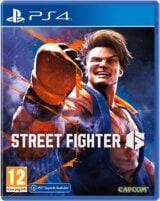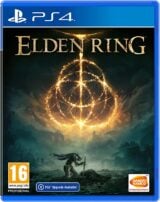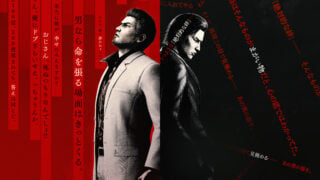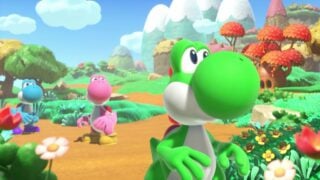Best Dreamcast games
From Power Stone to Shenmue: The best buys for Sega’s final home console

This article is provided by Tired Old Hack.
It wasn’t always just Sony, Microsoft and Nintendo competing in the video game hardware race: Back in the day Sega was a major competitor, with the Master System and Mega Drive / Genesis shifting in hefty numbers worldwide.
After its fourth standalone console – the overpriced Saturn – crumbled against the Nintendo 64 and newcomer Sony’s game-changing PlayStation, Sega’s next system would either make or break the company’s hardware future. Sadly, it would end up doing the latter.

It’s a shame, because the Dreamcast was miles ahead of its time: not just figuratively, but literally. Releasing in 1998 in Japan (and 1999 in the west), Sega’s console was the first of its generation by a clear year and a half (PS2 came in 2000, followed by Xbox and GameCube in 2001).
This meant Sega enjoyed offering vastly superior graphics to its competitors for nearly 18 months, something that the company assumed would help it get off to a massive head start over its rivals.
It wasn’t just a looker, though. The Dreamcast also boasted features that no other console had, such as a built-in 33.3kbps dial-up modem at a time when online gaming was the sole domain of rich people with big PC rigs. Then there was the VMU, a memory card with a built-in LCD screen that could be used to play little mini-games on the move.
As for the games, Sega was riding high in the arcades with numerous brilliant coin-op titles, and the powerful Dreamcast quickly became the home of countless arcade-perfect home ports, all exclusive to Sega’s console.
Ultimately, despite all this, it still wasn’t enough. In events that would parallel those of the Wii U nearly a decade and a half later, it was clear many were simply happy to wait until Sony and Microsoft released their consoles. The next generation didn’t start until they said it did.
As a result, Sega officially discontinued the Dreamcast in March 2001, a mere 18 months after it had launched in the west, with 10.1 million hardware sales under its belt (that’s even less than the Wii U). The Dreamcast was the final nail in a hardware coffin made up of recycled Mega CD, 32X and Saturn packaging, and Sega announced it was no longer making hardware.
You can find Dreamcasts fairly cheaply on eBay, so if you fancy catching up on a system with one of the greatest ‘good game – bad game’ ratios of all time, here’s our list of the best Dreamcast games ever.
Cannon Spike

What it is: A criminally underrated beat ’em up with guest appearances from a number of Capcom characters.
Why it’s Essential: Capcom’s brawler is a brilliant arcade-style effort in which you get to play as the likes of Cammy and Charlie from Street Fighter, Arthur from Ghouls N Ghosts and even Mega Man.Yes, it’s a game in which Cammy and Mega Man team up to kick the stuffing out of people. If you weren’t aware of it before, you’re welcome.
Crazy Taxi 1 & 2
What it is: Proof that The Offspring were once relevant.
Why it’s Essential: The great thing about the Dreamcast was that most of Sega’s arcade output at the time ended up on its console before any other (or indeed at all in many cases).
As a result, Crazy Taxi was a Dreamcast exclusive for a while, giving the system a genuinely brilliant arcade racer that actually had a surprising amount of depth.
If you aren’t familiar with it, the name should say it all: sat behind the wheel of a taxi (or a rickshaw once you unlock it), you have to pick up all manner of weird and wonderful passengers and take them to the likes of the football stadium, the police station or even licensed shops like KFC, Pizza Hut or Tower Records.
It was also well loved for its soundtrack, which fit the game like a glove. Despite only consisting of two Offspring songs and two Bad Religion ones, anyone who had a Dreamcast still spontaneously thinks, “YEAH, YEAH, YEAH, YEAH, YEAH” as soon as they think about Crazy Taxi.
Initially designed for quick 5-minute bursts, spend countless hours with it like I did and you’ll slowly be able to make each game last upwards of 45 minutes, memorising where all the customers are and figuring out the optimum order in which to pick them up and drop them off.
Dead Or Alive 2
What it is: The second in Tecmo’s fighting series.
Why it’s Essential: Back when Dead Or Alive 2 was released, the focus was still on the brilliant fighting engine, which combined a simple block and reversal mechanic with spectacular moves that were easy to pull off.
The result was a game that made you feel like you were in a Jackie Chan film with very little effort: while Street Fighter evolved to become ever more technical, Dead Or Alive was just about having fun and looking cool doing it.
Over the years the series has sadly switched its focus to what was once a minor feature: the fact that the female fighters’ breasts jiggled in a ‘realistic’ (i.e. exaggerated) manner when they moved. Dead Or Alive 2 is a reminder of (slightly) more innocent times.
Dynamite Cop
“Throughout its short campaign you’ll fire a rocket at a giant octopus, swing a harpoon around your head like a maniac and batter a chef with, yes, a giant fish.”
What it is: A police-themed beat ’em up in which, at one point, you beat someone to death with an enormous fish.
Why it’s Essential: Back in the day Sega released Die Hard Arcade, a coin-op beat ’em up based on the much-loved Bruce Willis movie. The game was such a massive success that a sequel was inevitable, but by then Sega no longer had the Die Hard licence.
So instead, it came up with Dynamite Cop (or Dynamite Deka 2, as it was known in Japan), which was basically the same game but with Bruce Willis replaced with Bruno Delinger, a similarly meatheaded chap with a little more hair than Bruce.
And it’s mental: Throughout its short campaign you’ll fire a rocket at a giant octopus, swing a harpoon around your head like a maniac and batter a chef with, yes, a giant fish.
Since it’s based on an arcade game it’s frustratingly short – you can finish it in about 30-45 minutes – but its branching storyline means there are a few completely different paths you can take, each with its own daft stages and enemies.
Evil Dead: Hail To The King
What it is: A Resident Evil clone based on the ultimate survival horror movie
Why it’s Essential: THQ released three Evil Dead games throughout the early 2000s, but while the more action-focused A Fistful Of Boomstick and Regeneration were widely regarded to be better, many preferred this first offering. Besides, it’s the only one that released for Dreamcast.
Hail To The King is set eight years after the events of Army of Darkness, and sees Ash (voiced by Bruce Campbell, who played him in the movies) returning to the cabin from The Evil Dead and Evil Dead 2 to face his demons once and for all.
Is it better than Resident Evil? No. But it’s packed with great fan service for Evil Dead devotees.
F355 Challenge
What it is: Sega’s attempt at the most realistic Ferrari simulator ever.
Why it’s Essential: Someone at Sega clearly loved Ferrari. Not only did Out Run and its sequels feature Ferrari cars (first unofficially, then licensed), the publisher’s AM2 studio also developed this ‘definitive’ Ferrari game.
As the name suggests, F355 Challenge features a grand total of one single car: the Ferrari F355. But at the time it was the most accurate video game version of a car ever made.
Sadly, the Dreamcast version didn’t feature the amazing three-screen mode seen in the arcade cabinet (which positioned three televisions side-by-side to expand the player’s viewpoint), but an extra five courses – including the Nurburgring and Laguna Seca – were added in compensation.
Fire Pro Wrestling D

What it is: The Dreamcast instalment in Human Entertainment and Spike’s superb wrestling series.
Why it’s Essential: There are wrestling game fans, and then there are Fire Pro fans. Only released in Japan for the most part (a GBA version came to Europe, and let’s pretend the Xbox Live Arcade one didn’t exist), Fire Pro is regarded by some as the finest wrestling series around.
WWF No Mercy is still arguably the greatest wrestling game ever, but Fire Pro remained consistently brilliant from its early PC Engine Super Famicom days all the way through to 2005’s Fire Pro Wrestling Returns on PS2.
This Dreamcast version features an insane 220 wrestlers from 16 organisations around the world (including unofficial WWF and WCW fighters) and includes such features as barbed wire deathmatches, exploding cage matches and up to eight wrestlers on-screen at the same time.
Grand Theft Auto 2
What it is: The second Grand Theft Auto game. Well, the third if you count GTA London 1969. And the fourth if you also count GTA London 1961.
Why it’s Essential: Back in the Dreamcast’s day, Grand Theft Auto was top-down. It was doing Hotline Miami before Hotline Miami.
Grand Theft Auto 2 has you wandering around Anywhere USA, juggling your services between three rival gangs and trying to keep them all happy.
To this day nothing in the series has felt more tense than wandering into Zaibatsu territory, having recently done jobs for the Yakuza and knowing your aren’t welcome.
Hydro Thunder
What it is: You know Wave Race? Well, imagine that if it had been an arcade game.
Why it’s Essential: For a period in the late ’90s Midway was the king of the hi-octane arcade racer.
Games like Off Road Thunder and San Francisco Rush delivered coin-operated spectacle on a consistent basis, and Hyrdo Thunder was no different.
At its core it’s a simple racing game, albeit one featuring speedboats instead of cars. But with ridiculous jumps, plenty of shortcuts and generous helpings of turbo boost included, it’s an immensely fun one.
Ikaruga
“Ikaruga adds a clever layer of strategy to the shoot ‘em up genre, which makes it a must-play.”
What it is: A clever shoot ‘em up by genre masters Treasure.
Why it’s Essential: Ikaruga is your typical Japanese bullet hell game in which the screen fills with bullets and the aim is as much to dodge between the gaps as it is to destroy your enemies.
What makes it interesting is its colour-changing mechanic. Each enemy is either black or white, as are their bullets, and players have the ability to change their ship’s colour at will.
If your ship is the same colour as an enemy’s bullet it can absorb it and build up a special weapon meter. However, your own shots are also weak against same-coloured enemies, so you need to keep alternating between absorbing their bullets and switching to the opposite colour to take them out more effectively.
Ikaruga adds a clever layer of strategy to the shoot ‘em up genre, which makes it a must-play.
Jet Set Radio
What it is: If you don’t like cel-shading, here’s the game to blame.
Why it’s Essential: It’s hard to believe but there was a time when Jet Set Radio (or Jet Grind Radio in America) looked refreshingly different.
This was a time when cel-shading was a new concept, and players instantly fell in love with its clean, comic book style visuals.
Of course, these days cel-shading is nothing new and so Jet Set Radio no longer looks so special. But what have stood the test of time are its brilliant rollerblading and graffiti spraying gameplay, and its irrefutably funky soundtrack.
Marvel vs Capcom 1 & 2
What it is: A Capcom/comics cavalcade
Why it’s Essential: For those that love fighting games that look as good as they play, Marvel vs Capcom and its sequel tick every box.
The latter in particular is just ridiculous, with 28 Marvel characters squaring off against 28 Capcom veterans, allowing players to finally live out their Iron Man vs Mega Man dreams.
MDK2

What it is: The sequel to Shiny Entertainment’s cult adventure game.
Why it’s Essential: After making the world chuckle childishly to the daft Earthworm Jim, developer Shiny Entertainment surprised players with its next game, the uncharacteristically dark MDK.
When it came to the sequel, Shiny was too busy working on its new game Messiah, so a little studio by the name of Bioware developed MDK2 instead.
This second helping offers more of the same, once again combining the first game’s brilliant Arkham-style gliding mechanic with beautiful, satisfying combat.
Metropolis Street Racer
What it is: Precursor to the Project Gotham Racing games.
Why it’s Essential: Before it started working on racing games for Microsoft, developer Bizarre Creations first released this fantastic Dreamcast exclusive.
Metropolis Street Racer was, to all intents and purposes, Project Gotham Racing 0. It introduced many of the Xbox series’ trademark selling points, including its then-unique Kudos system and its realistic recreations of real-world cities: in this case London, Tokyo and San Francisco.
Obviously it looks a little dated these days, but it’s a testament to Bizarre’s design that it still holds up as a fun racer.
NBA 2K series
What it is: A trio of quality basketball titles from Sega.
Why it’s Essential: Despite EA‘s dominance in the field, the best presentation you’ll see in a sports game these days is 2K Sports’ NBA 2K15.
This isn’t a new phenomenon: The NBA 2K series has been consistently fantastic ever since… well, the year 2K, and the three offerings on Dreamcast easily outshined their PS2 equivalents on a visual level.
Even better for Dreamcast owners, they were exclusive to Sega’s console. That’s because the 2K series originally belonged to Sega before Take-Two Interactive bought it in 2005 and created the 2K Sports label.
NFL 2K series
“The NFL 2K games were far superior to Madden, to the extent that to this day some hardcore fans still play NFL 2K2 rather than EA’s modern annual instalments.”
What it is: The same, only with football.
Why it’s Essential: As noted above, basketball fans are fortunate in that they have two franchises to choose between each year (NBA 2K and EA’s NBA Live), creating competition and encouraging each series’ developer to raise the bar every year.
This is also the case if you’re a football fan (FIFA and PES), a baseball fan (MLB The Show and MLB 2K), even a tennis fan (Top Spin, Virtua Tennis and EA Grand Slam Tennis). If you’re a fan of the American brand of football, however, there is no such choice: Madden dominates the market.
This wasn’t always the case: back in 2000, Sega competed with EA’s Madden NFL series with its own NFL 2K series. Many agreed the NFL 2K games were far superior to Madden, to the extent that to this day some hardcore fans still play NFL 2K2 rather than EA’s modern annual instalments.
Power Stone 1 & 2
What it is: Free-roaming arena-based fighting game from Capcom.
Why it’s Essential: Capcom’s Power Stone is a series many would love to see return to current-gen gaming.
At the time it was a revelation: a standard one-on-one fighter, only instead of limiting players to a single 2D plane they were able to roam wherever they liked in large 3D areas and use any weaponry or scenery available to them.
This led to a multitude of tactical possibilities for each stage. Did you head for the balconies and try chucking stuff at your opponent from afar? Did you get up close and try going hand-to-hand?
Did you go with a speedy fighter who could more easily avoid flung projectiles, or did you opt for a massive, bulky brute who could literally pluck lampposts out of the ground and swing them around?
Power Stone 2 upped the ante by introducing 4-player battles, making things even more ridiculous and therefore glorious.
Re-Volt
What it is: A racing game featuring remote-controlled cars.
Why it’s Essential: Games featuring RC cars are almost always great. The Rare-developed RC Pro-Am was a brilliant NES and Game Boy racer, while Vita game Motorstorm RC was another, more recent triumph for toy motor gaming.
Whereas those games featured an isometric viewpoint – which made sense, as it was as if you were looking down at the toy car you’re controlling – Re-Volt defied realism by switching to the more traditional third-person chase cam used in most racing games.
This let you see what it was like from the car’s point of view, making its massive Honey I Shrunk The Kids courses (including a brilliant one taking place on a suburban street) a delight.
Its extremely twitchy handling takes some getting used to, but once it clicks it’s fantastic fun.
Rez

What it is: The coolest game on the Dreamcast, or any system.
Why it’s Essential: It’s difficult to describe Rez in a way that sounds appealing to those who haven’t yet played it. It’s only when you experience it, that the true beauty of Rez becomes clear.
Tetsuya Mizuguchi‘s psychedelic shooter was one of the first games where the music wasn’t just there for the sake of it, it was actually part of the game.
The thumping score evolves as you progress through each level, while enemies explode to the beat in synchronised, harmonious bliss. Lovely stuff.
Samba De Amigo
What it is: A rhythm action game featuring a perpetually grinning, maraca-shaking monkey.
Why it’s Essential: One of the things Dreamcast did before everybody else was obsess over daft, oversized plastic controllers long before Guitar Hero, Rock Band et al hit the scene.
Samba De Amigo is a shining example of this. Costing over $100, it came with a set of motion-sensing maracas.
At a time before motion-sensing became the sort of thing gaming snobs turned their noses up at, Dreamcast owners shook their maracas about like goons to the likes of Livin’ La Vida Loca and the Macarena.
San Francisco Rush 2049
What it is: Futuristic street racing with some of the daftest jumps you’ll ever see
Why it’s Essential: Remember how Midway was the king of arcade-style racing games? This is exhibit B.
Taking place in a futuristic version of San Francisco (round about the year 2049, funnily enough), this was a racer that seemed to say: “You and I both know you want to see some cool stuff. So here it is.”
To this day when players think of big jumps in racing games, San Francisco Rush 2049 is the first game that immediately springs to mind.
Sega Rally Championship 2
“For players who want to spend half an hour adjusting their car’s suspension and camber, this isn’t for you.”
What it is: The second in Sega’s rally series and the reason many televisions in 1999 were barking “VERY LONG MEDIUM LEFT MAYBE” at their owners.
Why it’s Essential: The Colin McRae Rally series – which continues to this day under its new Dirt moniker – is generally considered to be the best source of entertainment for rally fans. That’s in a world without Sega Rally Championship 2, Sega AM5’s brilliant arcade racer which left realism stuck in the mud.
For players who want to spend half an hour adjusting their car’s suspension and camber, this isn’t for you. Instead, Sega Rally has you swinging out impossibly long powerslides across snowy roads, while your sort-of-Japanese navigator hollers “CAUTION HAIRPIN RIGHT” at you.
Shenmue 1 & 2
What it is: The greatest story never told. Not fully, anyway.
Why it’s Essential: These days Shenmue doesn’t seem so special. But at the time of its release, Shenmue was ground-breaking. A murder mystery taking place in a living, breathing village? A little shopping area full of buildings that weren’t just scenery but could almost all be entered?
There’s a reason so many people never gave up their campaign for Shenmue 3, and it isn’t because we think the first two hold up particularly well today as modern games. It’s because we didn’t just play Shenmue, we felt it. We were all Ryo. And we still have unfinished business.
SoulCalibur
What it is: The ultimate weapons-based fighter.
Why it’s Essential: A lot of people forget SoulCalibur was actually the second game in Namco’s Soul series, one which began with Soul Blade. That’s because SoulCalibur had a far greater impact.
Soul Blade was brilliant too, but it was released on a system (the PlayStation) that already had a wealth of brilliant fighting games: Tekken, Dead Or Alive, Battle Arena Toshinden and so forth.
SoulCalibur was the first fighting game on the Dreamcast and, as a result, the first truly next-gen fighter. And it looked incredible. In fact, we’d go so far as to say that it still looks brilliant all these years later, and how many polygonal games can you say that about?
Bandai Namco’s currently on its fifth SoulCalibur game, but none have had anywhere near the same impact as that Dreamcast classic.
Space Channel 5 Part 1 & 2

What it is: More rhythm action, this time courtesy of a stylish intergalactic news reporter.
Why it’s Essential: Space Channel 5 puts you in the knee high space-boots of Ulala, a news correspondent for intergalactic TV station Space Channel 5, and a lady with a penchant for the sort of clothes people in the ’60s thought we’d be wearing in the year 2000.
Ulala has to rescue hostages kidnapped by space aliens, and naturally she does this by dancing at them.
It gets even sillier in the second game, where her friend Michael Jackson (as in the actual one, voice and all) joins her.
Star Wars Episode I Racer
What it is: A genuinely good thing to come out of the Star Wars prequel trilogy.
Why it’s Essential: Someone cynical might suggest that the only reason George Lucas put a lengthy pod racing section in Star Wars Episode I was so that it could be spun-off into a video game. And they’re probably right.
Basically, imagine a WipEout game set in the Star Wars universe and you’re on the right track. And as an added bonus, you don’t have to play as Anakin Skywalker.
Toy Commander
What it is: An Army Men game done right.
Why it’s Essential: Blatantly inspired by Toy Story, Toy Commander tells the story of a group of toys troubled that the boy who owns them is now obsessed with army stuff. When he gets a bunch of army stuff (mostly vehicles, conveniently) for Christmas, the other toys decide to start a war with them.
The result? Players get to take on a bunch of weird and wonderful missions which usually involve switching between cars, tanks, helicopters, planes and the like so they can each do their own bit.
Because it all takes place with tiny vehicles in a house, these epic missions are sometimes menial tasks. Boiling eggs will never feel the same again when you aren’t using a car to roll the eggs into the pot.
TrickStyle
“Imagine a game in which hoverboards were used for racing and Tony Hawk style trick challenges… developed by a little British studio called Criterion Games”
What it is: A futuristic hoverboarding game published by Acclaim.
Why it’s Essential: If you’ve ever seen Back To The Future Part 2, you don’t need us to sell you on hoverboards.
Now, imagine a game in which hoverboards were used for racing and Tony Hawk style trick challenges, set in futuristic versions of London, Tokyo and New York, and developed by a little British studio called Criterion Games, shortly before they started work on its new series, Burnout.
Virtua Striker 2
What it is: A Sega-developed football game.
Why it’s Essential: At a time when people were playing ISS and FIFA games, nobody paid any attention to Virtua Striker, mainly because it wasn’t very good. At least, at first.
But this arcade football sequel, replete with Sega’s trademark ‘chunky’ feel, only really came into its own if you spent a few hours learning what makes it tick. Eventually you could string together some amazing passes and score some ridiculous long-range goals, with the over-excited announcer screaming like crazy.
It also featured two bizarre hidden teams: MVP Royal Genki (a team made up of aliens) and MVP Yukichan. The latter consisted of a variety of weird and wonderful characters, including mariachis, Eskimos, a big snowman wearing earmuffs and a ghost.
Virtua Tennis 1 & 2
What it is: Still one of the best tennis games ever.
Why it’s Essential: There’s a tendency in modern tennis games to complicate things with loads of different shot types, timing gimmicks, spin features and the like. It’s all well and good, but in a fast-paced sport like tennis the learning curve is too steep.
Virtua Tennis boils the entire sport down to two buttons: shot and lob. Despite (or maybe because of) this simplified approach, it’s one of the finest multiplayer games ever created.
Honourable mentions
Bangai-O
Shooter experts Treasure first released 10,000 copies of this classic on Nintendo 64 before porting it to Dreamcast. It’s a great risk/reward shooter, in which the size of your special attack depends on how many enemy bullets are on-screen.
Cyber Troopers Virtual-On Oratorio Tangram
This Sega AM3 fighter puts you behind a massive mech and tasks you with destroying another one. It’s a bit janky these days but the spectacle alone is still worth the price of entry.
Dino Crisis
Close your eyes. Imagine Resident Evil with dinosaurs. Open your eyes.
Headhunter
Headhunter was Sega’s answer to Metal Gear Solid, with similar stealth ’em up sections.
Mr Driller
A much-loved action puzzle game, released only on the Dreamcast.
Pop ‘N Music 1, 2, 3 and 4
A brilliant rhythm action series with a xylophone-style nine-button controller.
Rayman 2: The Great Escape
Arguably the best version of Ubisoft’s 3D platformer.
Ready 2 Rumble Boxing and Ready 2 Rumble Boxing Round 2
Midway’s comedy boxing games. The second is the better game, because it features a number of celebrity opponents, including Shaquille O’Neal, Bill and Hillary Clinton.
Resident Evil 2, 3 and Code: Veronica
Code: Veronica was originally a Dreamcast exclusive, while the others are faithful ports of the PlayStation titles.
Sega GT
Sega’s answer to Sony’s Gran Turismo games includes over 130 cars and 22 different tracks.
Sonic Adventure 1 and 2
Arguably the last two genuinely great 3D Sonic games. Ignore the bad voice acting and even worse music, these still offer enough lovely set-pieces to be worth playing.
Street Fighter III: 3rd Strike
A 2D fighting game so strategically in-depth that fighting game tournaments continue to feature it to this day.
The House Of The Dead 2
A home port of Sega’s so-bad-it’s-good B-movie lightgun shooter.
Ultimate Fighting Championship
Long before UFC, Crave Entertainment released this technical one-on-one fighter. Developer Anchor Inc went on to make the WWF Raw games for Xbox, with mixed results.
Virtua Fighter 3tb
The Dreamcast’s short lifespan meant this was the only Virtua Fighter game released for it. The ‘tb’ bit stands for Team Battle.














